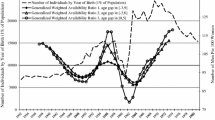Abstract
This paper examines how differences in sex drives between husbands and wives affect bargaining strengths during marriage and particularly at times when divorce might occur. The basic argument follows from the fact that sex drives vary over an individual's life cycle, and are systematically different for men and women. The spouse having the lowest sex drive at any time in the marriage has a property right over whether or not sexual intercourse will occur, with a consequent increase in bargaining power at the margin. The paper derives a number of testable implications from its model, and, using several data sources, shows empirically how this difference affects marriage, adultery and divorce.
Similar content being viewed by others
References
Allen, Douglas W. (1990). “An Inquiry Into the State's Role in Marriage.” Journal of Economic Behavior and Organization. 13(2).
---. (June 1992) “Marriage and Divorce: Comment.” American Economic Review.
Altman, Lawrence. (December 22, 1993). “Study Suggests High Rate of Impotence.” The New York Times Section C, p.13.
Anderson, Gary and Tollison, Robert. (1991). “A Theory of Rational Childhood.” European Journal of Political Economy, 7.
Aristophanes. (1964). Lysistrata, New York: Mentor Books, Douglass Parker trans.
Baker, Robin and Bellis, Mark. (1993). “Human Sperm Competition: Ejaculate Manipulation by Females and a Function for the Female Orgasms”. Animal Behavior, 46.
Becker, Gary, Landes, Elizabeth, and Michael, Robert. (Dec. 1977). “An Economic Analysis of Marital Instability.” Journal of Political Economy. 85.
Blumstein, Phillip and Schwartz, Pepper. (1983). American Couples: Money, Work, Sex, New York: William Morrow.
Braver, Sanford, Whitley, Marnie, and Ng. Christine. (1993). “Who Divorced Whom?: Methodological and Theoretical Issues.” Journal of Divorce and Remarriage. 20.
Brinig, Margaret. (forthcoming). “No-Fault Divorce.” In Peter Newman. (ed.). New Palgrave Dictionary of Economics and the Law. London: MacMillan Press.
---. (1993). “The Law and Economics of No-Fault Divorce.” Family Law Quarterly. 453.
--- and Crafton, Steve. (1994). “Marriage and Opportunism.” Journal of Legal Studies. 23.
--- and Frank Buckley. (forthcoming). “No-Fault Laws and At Fault People.” International Review of Law and Economics. 1997.
Bumpass, Larry, Sweet, James and Cherlin, Andrew. (1991). “The Role of Cohabitation in Declining Rates of Marriage.” Journal of Marriage and the Family. 53.
Cohen, Lloyd. (1987). “Marriage, Divorce, and Quasi Rents; Or, 'I Gave Him The Best Years of My Life'.” Journal of Legal Studies, 16.
Finnie, Ross. (1995). “The Economics of Divorce.” Family Matters: New Policies for Divorce, Lone Mothers, and Child Poverty. Toronto: C.D. Howe Institute.
Friedman, Lawrence W. and Percival, Robert V. (1976). “Who Sues for Divorce? From Fault Through Fiction to Freedom.” Journal of Legal Studies. 61.
Gallagher, Winifred. (1988). “Sex and Hormones.” The Atlantic Monthly. March.
Gunter, B.G. and Johnson, Doyle. (1978). “Divorce Filing as Role Behavior: Effect of No-Fault Law on Divorce Filing Patterns.” Journal of Marriage and Family. 571.
Kennedy, Peter. (1985). A Guide To Econometrics, Cambridge: MIT Press.
Kinsey, Alfred, et al. (1968). Sexual Behavior in the Human Female, Philadelphia: W. B. Saunders Co.
Laumann, Edward, Gagnon, John, Michael, Robert and Michaels, Stuart. (1994). The Social Organization of Sexuality: Sexual Practices in the United States, Chicago: The University of Chicago Press.
Lundberg, Shelly and Pollak, Robert. (1993). “Separate Spheres Bargaining and the Marriage Market.” Journal of Political Economy. 101.
Mahoney, E.R. (1983). Human Sexuality, New York: McGraw-Hill.
Newman, Gustave and Nichols, Claude. (1970). “Sexual Activities and Attitudes in Older Persons.” Studies in Human Sexual Behavior: The American Scene, Springfield: Charles Thomas.
Parkman, Allen. (1992). No-Fault Divorce: What Went Wrong, Boulder: Westview.
Perlmutter, Cathy. (July 1989). “31 facts and tips on sex after 30.” Prevention. 41.
Person, Ethel. (March 1988). “Some Differences Between Men and Women.” The Atlantic Monthly.
Peters, H. Elizabeth. (June 1986). “Marriage and Divorce: Informational Constraints and Private Contracting.” American Economic Review, 76.
Posner, Richard. (1992). Sex and Reason, Cambridge: Harvard University Press.
Reinisch, June M. and Beasley, Ruth. (1991). The Kinsey Institute New Report on Sex, New York: St. Martin's Press.
Zelder, Martin. (1993). “Inefficient Dissolutions as a Consequence of Public Goods: The Case of No-Fault Divorce.” Journal of Legal Studies, 22.
Author information
Authors and Affiliations
Rights and permissions
About this article
Cite this article
Allen, D., Brinig, M. Sex, Property Rights, and Divorce. European Journal of Law and Economics 5, 211–233 (1998). https://doi.org/10.1023/A:1008626732094
Issue Date:
DOI: https://doi.org/10.1023/A:1008626732094




